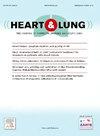Evaluation of pharmacological thromboprophylaxis in critically Ill elderly patients: A multicenter cohort Study
IF 2.6
4区 医学
Q2 CARDIAC & CARDIOVASCULAR SYSTEMS
引用次数: 0
Abstract
Background
Older adults are at a higher risk of developing venous thromboembolism (VTE), particularly when admitted to the Intensive Care Units (ICUs). Parenteral anticoagulation is the primary method used for thromboprophylaxis in critically ill patients.Nonetheless, there is limited evidence on the most effective pharmacological agents for thromboprophylaxis and their dosages specifically for older adults in critical care settings..
Objective
This study aims to evaluate the effectiveness and safety of pharmacological VTE prophylaxis in critically ill older adults.
Method
This multi-center retrospective cohort study involved critically ill older adults aged 65 and above who were admitted to ICUs and received pharmacological thromboprophylaxis. Patients were categorized into two sub-cohorts based on the type of pharmacological thromboprophylaxis they received: subcutaneous unfractionated heparin (UFH) or low molecular weight heparin (LMWH); enoxaparin. The primary endpoint was major bleeding, while secondary endpoints were minor bleeding, all thrombosis cases, ICU and hospital length of stay, mechanical ventilation (MV) duration, and other ICU complications. A propensity score (PS) matching was utilized using a (2:1) ratio between patients who received UFH and enoxaparin as prophylaxis.
Results
After PS matching, we included 210 patients based on predefined criteria, with 140 patients in the UFH group and 70 in the enoxaparin group. The major bleeding events were lower in the enoxaparin group compared with UFH (10.7 % to 2.9 %; p-value=0.05); however, it failed to reach the statistical significance at regression analysis (OR: 0.25, 95 %CI: 0.10, 1.13; P = 0.07). All thrombotic events and rate of minor bleeding were not statistically significantly different between the two groups (OR 1.29, 95 % CI: 0.58, 2.84; P-value= 0.53 and OR: 0.54, 95 % CI: 0.25, 1.14, P = 0.11, respectively). In addition, the 30-day and in-hospital mortality rates were not statistically significantly different between the two groups (OR: 0.75, 95 %CI: 0.37, 1.52, P = 0.43 and OR: 0.65, 95 %CI: 0.33, 1.30, P = 0.21, respectively).
Conclusion
Enoxaparin as VTE prophylaxis in critically ill older adults showed a trend towards lower rates of major bleeding, although the difference was not statistically significant. In contrast, there were no notable differences in thrombosis rates among this patient group. Future randomized controlled trials are required to confirm our findings and explore long-term outcomes.
危重老年患者血栓预防药理学评价:一项多中心队列研究
年龄较大的成年人发生静脉血栓栓塞(VTE)的风险较高,特别是在入住重症监护病房(icu)时。肠外抗凝是危重患者预防血栓的主要方法。尽管如此,关于最有效的血栓预防药物及其剂量的证据有限,特别是对于危重重症老年人。目的本研究旨在评估危重老年人静脉血栓栓塞药物预防的有效性和安全性。方法本多中心回顾性队列研究纳入65岁及以上重症监护病房并接受血栓预防药物治疗的危重老年人。根据患者接受的药物血栓预防类型,将患者分为两个亚队列:皮下未分离肝素(UFH)或低分子量肝素(LMWH);伊诺肝素。主要终点为大出血,次要终点为小出血、所有血栓病例、ICU和住院时间、机械通气(MV)时间以及其他ICU并发症。倾向评分(PS)匹配使用(2:1)比例的患者接受UFH和依诺肝素作为预防。结果在PS匹配后,我们根据预定义的标准纳入了210例患者,其中140例为UFH组,70例为依诺肝素组。与UFH相比,依诺肝素组的主要出血事件较低(10.7%至2.9%;假定值= 0.05);但经回归分析未达到统计学显著性(OR: 0.25, 95% CI: 0.10, 1.13;P = 0.07)。两组间所有血栓形成事件和小出血发生率差异无统计学意义(OR 1.29, 95% CI: 0.58, 2.84;P值= 0.53,OR: 0.54, 95% CI: 0.25, 1.14, P = 0.11)。此外,两组患者的30天死亡率和住院死亡率差异无统计学意义(OR: 0.75, 95% CI: 0.37, 1.52, P = 0.43; OR: 0.65, 95% CI: 0.33, 1.30, P = 0.21)。结论依诺肝素预防危重老年人静脉血栓栓塞有降低大出血发生率的趋势,但差异无统计学意义。相比之下,该患者组的血栓发生率无显著差异。需要未来的随机对照试验来证实我们的发现并探索长期结果。
本文章由计算机程序翻译,如有差异,请以英文原文为准。
求助全文
约1分钟内获得全文
求助全文
来源期刊

Heart & Lung
医学-呼吸系统
CiteScore
4.60
自引率
3.60%
发文量
184
审稿时长
35 days
期刊介绍:
Heart & Lung: The Journal of Cardiopulmonary and Acute Care, the official publication of The American Association of Heart Failure Nurses, presents original, peer-reviewed articles on techniques, advances, investigations, and observations related to the care of patients with acute and critical illness and patients with chronic cardiac or pulmonary disorders.
The Journal''s acute care articles focus on the care of hospitalized patients, including those in the critical and acute care settings. Because most patients who are hospitalized in acute and critical care settings have chronic conditions, we are also interested in the chronically critically ill, the care of patients with chronic cardiopulmonary disorders, their rehabilitation, and disease prevention. The Journal''s heart failure articles focus on all aspects of the care of patients with this condition. Manuscripts that are relevant to populations across the human lifespan are welcome.
 求助内容:
求助内容: 应助结果提醒方式:
应助结果提醒方式:


